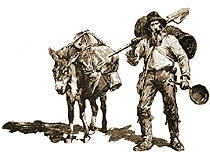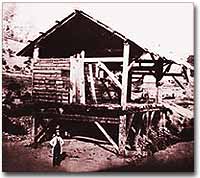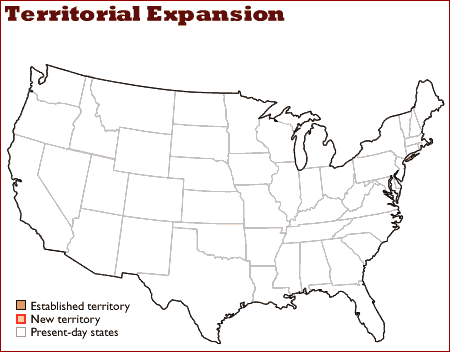29e. Gold in California

In January of 1848, a man named James Marshall innocently noticed a few shiny flecks in a California stream at Sutter's Mill. Word spread of gold and soon people from all over California flocked inland seeking instant fortune. By autumn, word had reached the east, and once again Americans earned their reputation as a migratory people. During the year that followed, over 80,000 "forty-niners" flocked to California to share in the glory. Some would actually strike it rich, but most would not.
Life in a mining town was not easy. Often the towns consisted of one main street. It is in these towns that the mythical "Old American West" was born. The social center of these new communities was the saloon. Here, miners might spend some of their meager earnings after a hard day's work. Gambling, drinking, and fighting were widespread, and justice was often determined by the hardest punch or the fastest draw. About 95% of the mining population was young and male. Female companionship was in high demand. Sometimes the saloon doubled as a brothel, and as many as 20% of the female population earned their living as prostitutes. Many other women were shopkeepers and businesswomen, and some were panning for gold side by side with the men.

This photograph of Sutter's Mill was taken in 1852, four years after the discovery that began the gold rush.
If a nearby mine became exhausted or turned out to be a hoax, there was no reason for the town to exist. The abandoned ghost towns began to dot the region.
Although predominantly young and male, the population of California was very diverse. In addition to the white American settlers who comprised the majority of the mining populace, free African-Americans could also be found among their ranks. More numerous were Mexicans who were hoping to strike it rich. Word reached European shores and immigrants headed to America's west. German-Jewish immigrant Levi Strauss invented trousers for the miners — his blue jeans became an American mainstay. Another significant segment of the diversity was the Chinese, who hoped to find gold and return to their homeland. Over 45,000 immigrants swelled the population between 1849 and 1854. Diversity did not bring harmony. The white majority often attacked the Mexican and Chinese minorities. The miners ruthlessly forced the California Native Americans off their lands. Laws were passed to restrict new land claims to white Americans.

Between 1800 and 1854, U.S. territory had grown from the original 13 colonies to the limits of today's continental United States.
The California Gold Rush soon peaked, and by the mid-1850s California life stabilized. But the pattern established there was repeated elsewhere — in Colorado, South Dakota, and Nevada, among others. As in California, ambition merged with opportunity and ruthlessness — ethnic and racial discrimination was part of the legacy of the American West.




 Click for California history Merchandise!
Click for California history Merchandise!

